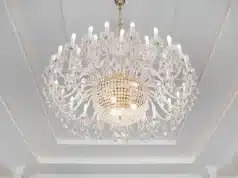The roof on our homes doesn’t receive enough credit. Do 30 year shingles really last 30 years? What weather can damage a roof? Find out roofing facts and trivia
We don’t give enough credit to the roof we have over our heads.
The roof of our home is what gives us shelter, but what do we really know about it?
Keep reading to learn some roofing facts you can’t overlook.
One Of The Key Roofing Facts: Where You Live Determines Your Roof Style
You might not even realize this, but some types of roofs actually work better in certain climate and regions. Take Gable roofs for example.
These roofs are formed by two triangles at a 90-degree angle and they’re ideal for snowy cold climates. These roofs are also ideal if the homeowners wish to have an attic with a vaulted ceiling.
Hipped roofs on the other hand, which are the roofs that have four slopes of equal length on all four sides that join at the top to form a ridge, are more wind resistant than let’s say a gable roof. So if you live in a windy area, you’re more likely to have a hipped roof over a gable one. Team Roofing, an Atlanta roofing company, can help you determine which type of roof is the right choice for your home, as this area’s stormy weather and hot summers can make this decision more complicated.
If you live in an area where it rains all the time, you don’t want a flat roof. Flat roofs make it easy for water to pool, and are best for drier less rainy climates.
Water tends to pool more easily on a flat roof, which means this type of roofing system might be best in a drier, less rainy climate. Also, flat roofs aren’t entirely flat, they do have a slight slope of about 1/4 of an inch per foot.
A Roof Is a Lot More Than Shingles and Wood
A solid roof has no less than seven key components. There the roof decking which supports all the weight of your roof system. Then there is the water or ice barrier which helps prevent damage if there’s any ice damming.
Your roof needs to either a water-resistant or waterproof underlayment to protect the deck from any moisture directly creeping in.
Next, there is usually a metal flashing. This ensures that water will run off the edges of the roof. There’s also a drip edge which acts similarly.
And lastly, your roof has shingles and a ventilation system which is known as the soffits, this vents which air is able to circulate.
There Are Different Types of Shingles
When it comes to shingles, they differ on many levels the first being what the shingles are made out of. There are two main varieties of shingles, either organic or fiberglass.
Fiberglass
Fiberglass shingles are made up of a layer of waterproof asphalt coating, a top layer of ceramic granules that protect from any damage caused by UV rays, and a woven fiberglass mat.
Since there is fiberglass, these shingles need less asphalt when they are manufactured. Because of this, you will have a more light-weight but still durable and fire resistant shingle. Ninety percent of all asphalt roofs in the United States are fiberglass shingles.
Organic
Organic shingles are made from recycled layers of felt paper which is saturated in asphalt. These layers are then coated with adhesive asphalt and embedded ceramic granules so there is extra protection.
Forty percent more asphalt is involved in the making of organic shingles compared to those made out of fiberglass. Which means that organic shingles are heavier, cost more and ironically despite being “organic” are actually worse for the environment. Organic shingles also don’t last very long, which is why they are rarely used on newer homes.
Shingles Design
Shingles can also vary in terms of how they are designed. There are about three main shingle styles.
3-Tab Shingles
This style is also referred to as “strip” as it’s made out of a single piece or layer of material and had two cutouts on it’s exposed surface. You also can get this design as a three-tab, slate-like look.
Laminate Shingles
This style is also referred to as “architectural,” as it contains a second set of shingles on top of the first one so it looks like it’s 3D while also having some resistance.
These are considered to be the best design of shingles for residential roofs and are bought the most frequently by homeowners. You can also get laminate shingles in premiums varieties and their line looks like wood shake and heavy slate.
Large Form Shingles
These are either horizontal or rectangular and have no tabs or cutouts on them.
The Lifespan Of A Shingle Roof
Most homeowners often wonder how long their roof is good for. Well, usually the least expensive roofs typically are the most prone to damage, temperature changes, hight winds, sun exposure, and storms.
You might see damage to these types of roofs in five to six years or less after the roof is installed. Overall, these roofs will last the shortest amount of time of an average of ten to twelve years.
Shingle granules are applied to your roof to protect your roof from UV rays, weather, and sunlight. When these granules begin to wear off, the faster your roof will age and leaks are more likely to happen.
A New Roof Can Up Your Resale Value
You might not want shingles if you plan to stay in your home for over five years. But if you’re looking to sell your house soon, shingles might be the best solution. Remodeling Magazine found that a new roof can actually increase the resale value of your home to a national average of about $12,000.
This is why it’s important that you think about implementing if your home has an older roof. Buyers will appreciate your improved curb appeal an not having to worry about leaks.
A Faulty Roof Can Break A Home Sale
Not only can a new roof help sell your home, on the same token a weak or faulty roof can break the sale of your home. Meaning a roof that has missing or damaged shingles, leaks or shows any other signs of disrepair. A new homeowner does not want to spend money repairing a roof, so you’ll want to fix your roof first before you sell your home.
Common weak spots on your roof are areas that are in need of protection from flashing. Common causes of roof leaks include damaged shingles or damaged waterproofing materials under your shingles.
You might need to fully replace your roof because of damaged shingles, but if the leak keeps happening and isn’t managed then there could be dry rot. Or if your roof is old, it will need to be replaced.
It’s Not Okay To Cover An Existing Roof
You might think a quick fix inexpensive fix to your roofing problems is to simply cover up your roof. When actually this does not solve the problem, as double layered roofs cover up big roofing issues that should be addressed.
Double layering roods also add weight by hiding the corroding material which just makes the problem worse. If earlier roofing materials were installed on top of your existing roof, you will need to replace your entire roof as soon as you can.
You Can’t DIY A Roof
You might think that almost any household issue can be fixed with a simple DIY, but this is not the case with roofs. A roof is actually an incredibly complex system of layers that need to be properly installed by a skilled professional who has the proper tools and training to make sure everything properly works together.
If you try to DIY your roof, you can damage your walls, wood frame, electrical systems, and attic. So don’t risk it and check out these roofing leads and get a professional to help you sooner rather than later.
Roofs Breathe
While it might sound counterproductive of what roofs are supposed to do, roofs actually need a little breathing space. Roof ventilation or the flow of air on the underside of your roof deck is one of the most key aspects of your entire roofing system.
Roof ventilation lets moist, warm arm escape, and drier cooler air come into your attic. If you don’t have this ventilation in your roof, then condensation will build up in your attic which can damage your insulation, wood, and walls.
A Roof Can Be Good For The Environment
“Cool roofs” are environmentally friendly and can reflect ultraviolet infrared rays from the sun away from the building. This can lead to a higher thermal emittance or the ability for the room to emit radiation efficiently. Cool roofs don’t only help homeowners with energy conservation, they also can reduce pollution and greenhouse gas emissions as well as mitigating heat that is radiated into the atmosphere.
Professional Roof Cleaning Companies Are Key
You want to keep your roof clean and maintained to extend your roof’s life. That means keeping your roof clear of fungus/lichen, algae and moss. Professional roof cleaners have special products and technique to properly clean your roof in a way that your shingles won’t get harmed.
Also, the cleaning solutions they use are biodegradable which is harmful to the environment and plants and the environment.
To understand the causes of a dirty roof, see Premier Roof Cleaning Inc’s website for more details.
Fix Your Roof Today
Now that you know these valuable roofing facts, make sure you keep your roof in the best shape it can be in. It doesn’t hurt to have a professional roofer check out your roof once in a while. It’s better to catch these problems early before you’re without a roof.
For more information on pretty much every aspect of your life, take a look at some of our other blog posts!

A professional writer with over a decade of incessant writing skills. Her topics of interest and expertise range from health, nutrition and psychology.



